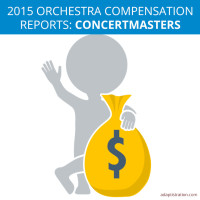 For the second season in a row, the average concertmaster experienced a decline in compensation, although that statistic is a bit misleading thanks to an unusual spike in the 2010/11 season for a single concertmaster with record setting compensation. When that figure is filtered out the equation, average concertmaster compensation had a small increase from 2010/11 to 2011/12 then a 2.69 percent drop from 2011/12 to 2012/13.
For the second season in a row, the average concertmaster experienced a decline in compensation, although that statistic is a bit misleading thanks to an unusual spike in the 2010/11 season for a single concertmaster with record setting compensation. When that figure is filtered out the equation, average concertmaster compensation had a small increase from 2010/11 to 2011/12 then a 2.69 percent drop from 2011/12 to 2012/13.
Otherwise, the 2012/13 season didn’t witness any unusual items other than one positive move in the form of a new entry into the list of ensembles that report concertmaster compensation: the Alabama Symphony.
The Information
In order to provide information that is as accurate as possible, info from the 2012/13 season is gathered from the following source:
- Concertmaster compensation figures were obtained from their respective orchestra’s IRS Form 990 for the 2012/13 concert season.
Adaptistration makes no claim to the accuracy of information from documents compiled or reported by external sources. If you have reason to believe any of the information is inaccurate or has changed since reported in any of the above sources and you can provide documentation to such effect, please feel free to use the following form to submit a notice.
An Important Note About Concertmaster Compensation Reporting
Due to the changes in the IRS Form 990 several years ago, there are fewer concertmaster figures to report as compared to executives and music directors. Up until the 2008/09 season, nonprofit organizations were required to list a fixed number of employees who earned over $50,000/year, but the IRS increased that threshold to $100,000 for the 2008/09 season.
Perhaps unsurprisingly, quite a few concertmasters earning more than $50,000 but less than $100,000 no longer appear on their respective orchestra’s From 990.
As a result, you’ll see a number of “Not Applicable” entries for most orchestras on the list, which is a sign that…
- their concertmaster position was unfilled for that season.
- the concertmaster earned less than $100,000 and was therefore not included in the filing.
- the concertmaster earned over $100,000 but because didn’t earn enough to be included in the threshold of employees listed in the 990.
Who Is This Concertmaster Person Anyway?
 For those not already familiar with the concertmaster position, this is the title reserved for the principal seat within the 1st violin section. More often than not, this is the musician you see walking out on stage at the beginning of the concert to initiate the orchestra’s tuning process before the conductor emerges.
For those not already familiar with the concertmaster position, this is the title reserved for the principal seat within the 1st violin section. More often than not, this is the musician you see walking out on stage at the beginning of the concert to initiate the orchestra’s tuning process before the conductor emerges.
Although concertmasters are included within every orchestra’s collective bargaining agreement, they also negotiate a mutually exclusive agreement with the orchestra detailing compensation and additional duties exclusive to that position. For example, it isn’t uncommon for a concertmaster to be featured as a soloist with the orchestra at least once a year. As such, their annual income will fluctuate based on the number of solo appearances and respective fees they negotiate with their organization.
Additionally, concertmasters are required to perform any of the numerous internal solos incorporated into any given piece of music (such as the famous violin solo from Scheherazade). Beyond actual performing duties, concertmasters (along with other principal seat string musicians) are usually required to perform additional duties such as bowings (which are markings placed throughout a string player’s sheet music that indicate which direction to move the bow. This allows each section of strings to move their bows in unison and enhance to the sense of phrasing a conductor wishes to use.
A common perk associated with many concertmaster individual contracts are clauses excluding them from having to perform during some non-masterwork oriented concerts (such as holiday, pops, or educational concerts). As this clause is not uniform, the frequency and type of concerts concertmasters are excluded from participating vary from one musician to the next. It is also one of the reasons why orchestras may have one or two additional violinists within the orchestra who serve under the title of associate or assistant concertmaster.
Regardless of the additional clauses a concertmaster negotiates in their personal contract, they are afforded the same base workplace protection and representation guaranteed all musicians under the organization’s collective bargaining agreement.
2012/13 Season Concertmaster Compensation

Top 10 Earners
- New York Philharmonic: $578,419
- San Francisco Symphony: $573,377
- Chicago Symphony: $553,333
- Cleveland Orchestra: $530,976
- Los Angeles Philharmonic: $518,145
- Boston Symphony: $467,930
- Philadelphia Orchestra: $363,587
- National Symphony: $347,102
- Pittsburgh Symphony: $300,483
- Baltimore Symphony: $283,814


